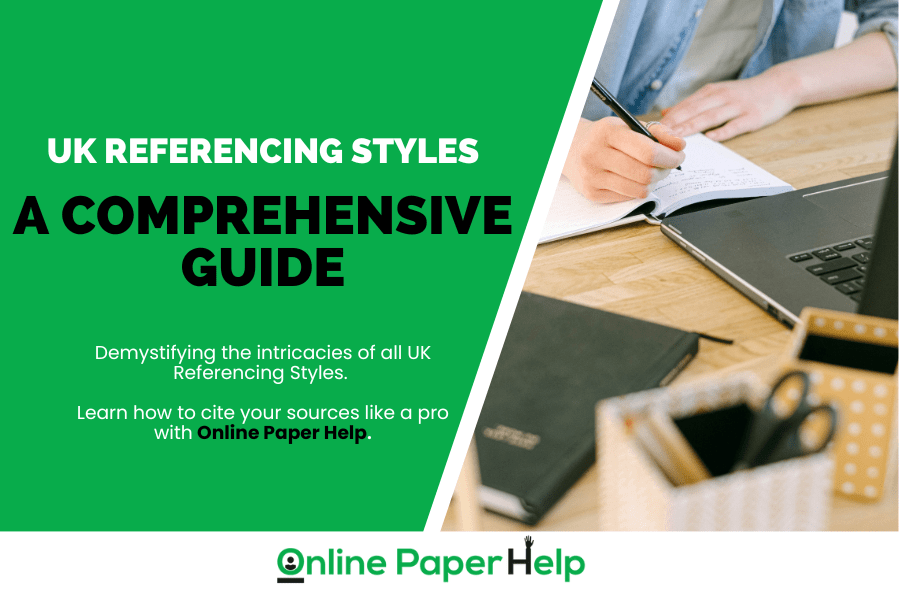UK Referencing Styles – A Comprehensive Guide
UK Referencing Styles – A Comprehensive Guide
In the United Kingdom, there are three widely used referencing styles: Harvard Referencing, APA referencing, and Oxford referencing. UK Referencing is essential to academic and professional writing, ensuring that your sources are correctly credited.
UK referencing styles encompass the guidelines and conventions writers and students follow when citing sources in their research papers, essays, or dissertations. These referencing methods serve as beacons of good scholarship, ensuring that the intellectual journey of knowledge exchange is transparent and credible.
In this article, we will discuss the Harvard referencing style, a widely adopted system known for its simplicity and effectiveness. Next, we will dive into the nuances of APA referencing, a method commonly used in social sciences, psychology, and education. Lastly, we will explain the Oxford referencing style, a prestigious and revered system often employed in humanities and the liberal arts.
Throughout this guide, we will explore the key elements and practical tips for using UK referencing styles effectively, ensuring that your writing is credible and authoritative and follows academic standards.
A. Importance of Proper Referencing
UK referencing styles are a set of conventions and rules that help you acknowledge the sources you’ve used in your academic work. It allows you to cite the work of a particular author, giving due credit to them. It prevents plagiarism and upholds intellectual honesty. Effective referencing contributes to the clarity and coherence of your writing. Moreover, proper referencing helps create a cohesive and interconnected knowledge network within academic and research communities.
Referencing serves as a safeguard against misrepresentation of facts. Attributing information to its original sources ensures that the information you present is as accurate as possible. A hallmark of a skilled researcher is meticulous attention to detail at all stages of their work. Paying close attention to referencing and bibliography preparation helps focus on the entire research process, promoting scientific thinking and analysis. Proper referencing is an essential aspect of academic and research writing that supports your arguments, builds on existing knowledge, prevents plagiarism, aids your readers, and enhances your credibility.
1. Harvard Referencing
Harvard referencing is one of the widely used referencing styles. It is known for its simplicity and clarity, which makes it a popular choice among students. In Harvard referencing, the author’s last name and the publication year are included within the text, and a complete reference list is provided at the end of the document. This style is ideal for in-text citations, making it easy for readers to locate the complete source in the reference list.
The reference list is typically arranged alphabetically by the author’s last name. In cases where there’s no author, the title of the source is used for referencing. When citing books, key elements include the author’s name, title, publisher, and publication year, while for journal articles, it involves the author’s name, article title, journal name, volume, and page numbers. Consistency in formatting within the reference list is crucial. Following are some examples of Harvard referencing.
Harvard Referencing Examples
Referencing for Book
Author(s). (Year). Title of the Book. Publisher.
Example: Smith, J. (2019). The Art of Writing. Penguin Books.
Referencing for Journal Article
Author(s). (Year). Title of the Article. Title of the Journal, Volume(Issue), Page range.
Example: Johnson, L. (2028). Creative Writing Techniques. Journal of Writing Studies, 5(2), pp. 45-58.
Referencing for Website
Author(s) or Organization. (Year). Title of the Webpage. Website Name. URL.
Example: Smithsonian Institution. (2021). History of Ancient Civilizations. Smithsonian. Available at: https://www.smithsonian.com/history/ancient-civilizations/
2. APA Referencing
For those working in scientific fields, the American Psychological Association (APA) referencing style is often the go-to choice in the UK. It is highly structured and detailed, making it perfect for research papers and academic articles. It requires a precise format for citing various sources, including books, journal articles, and websites.
According to APA guidelines, the title of the work should be italicized, with only the first word and proper nouns capitalized. For journal articles, it is essential to include the volume number and page range, along with the title of the journal in italics. If a Digital Object Identifier (DOI) is available, it should be included. In the text, author-date format in parentheses must be used for in-text citations. When quoting directly, it is essential to place the text in double quotation marks. The reference list should be a separate page, and each entry should have a hanging indentation. When citing multiple authors in-text, an ampersand (&) must be used. For direct quotes in the text, page numbers must be provided.
APA Referencing Examples
Referencing for Book
Author(s). (Year). Title of the book. Publisher.
Example: Smith, J. (2020). The Art of Creativity. XYZ Publications.
Referencing for Journal Article
Author(s). (Year). Title of the article. Title of the Journal, volume number(issue number), page range.
Example: Johnson, L. (2019). Innovations in Technology Education. Educational Innovations, 5(2), 112-127.
Referencing for Website
Author(s) or Organization. (Year). Title of the webpage or website. URL
Example: American Psychological Association. (2021). APA Style Guide. https://www.apastyle.org/
3. Oxford Referencing
Oxford referencing follows the note and bibliography system. It involves using footnotes and endnotes to cite sources. Each citation in a footnote includes essential details about the source, such as the author’s name, the title of the work, publication date, and page numbers, if applicable. This style is used mainly in humanities, as it allows for in-depth annotations and additional context within the notes. The reference list is presented at the end of the document, providing readers with a comprehensive list of sources.
Punctuation, such as commas and periods, is also important, and adhering to specific rules is crucial for proper citation. While Oxford referencing shares similarities with the Chicago style, it has distinct features and guidelines that set it apart. Footnotes, a hallmark of Oxford referencing, can be formatted as superscript numbers or symbols. They play a crucial role in distinguishing your ideas from borrowed information and give readers a clear understanding of the source materials.
Oxford Referencing Examples
Referencing for Book
1 A. Author, Title of Book in Italics: Subtitle in Italics, edition number, Place of Publication, Publisher, year, page number.
Example for footnotes: 1A. David, The History of Science, 1st edn., London, Oxford University Press, 2020, p.23
Example for referencing list: David, A., The History of Science, 1st edn., London, Oxford University Press, 2020
Referencing for Journal
1 A. Author, ‘Title of Article: Subtitle’, Title of Journal in Italics, vol. xx, no. xx, year, p. xx.
Example for footnotes: 1 S. Lisa, ‘Exploring New Frontiers in Medicine’, Health Innovations, vol.3 no.6, 2018, p. 44
Example for reference list: Lisa, S., ‘Exploring New Frontiers in Medicine’, Health Innovations, vol.3 no.6, 2018, pp. 44-46.
Referencing for Website
Author(s) Last Name, Author(s) First Name (if available), Title of the Webpage or Article (in double quotation marks), Name of the Website (in italics or underlined), URL, Access Date.
Example for footnotes: 1 Turner, The Impact of Climate Change on Biodiversity’, Environmental Studies, Oxford University Press, 2022, 135, http://www.examplewebsite.com/climate-change-biodiversity (accessed 8 October 2022).
Example for the reference list: Turner, The Impact of Climate Change on Biodiversity’, Environmental Studies, Oxford University Press, 2022, 135, http://www.examplewebsite.com/climate-change-biodiversity (accessed 8 october 2022).
B. UK Referencing Methods: Commonalities and Differences
1. Citations
All three styles, i.e., Harvard referencing style, APA referencing style, and Oxford referencing style, require in-text citations to acknowledge the source within the text. However, the format and placement of these citations differ from each other.
2. Reference Lists
In your academic and professional writing, you need to compile a list of all sources you have cited. This serves as a comprehensive record of your sources, and it helps readers locate them. The specific formatting of these lists may differ between styles.
3. Quotations
Properly including and citing direct quotes plays an important role in all three styles. To indicate text, quotation marks and page numbers are used. This ensures that you give credit to the original sources.
4. Digital Sources
In this digital era, the use of online sources has grown. These styles have been adapted to include guidelines for citing websites, eBooks, and any other digital work.
5. Footnotes/Endnotes
Oxford referencing is distinctive in its use of footnotes and endnotes to provide additional information or citations. On the other hand, Harvard and APA referencing rely more on in-cite text citations and don’t commonly use footnotes or endnotes.
6. Reference Page Layout
While Harvard and APA referencing have a specific layout for the reference page, with sources listed in alphabetical order, Oxford separates referencing into a bibliography at the end of the document.
7. Punctuation and Capitalization
Each referencing style has its own rules regarding punctuation and capitalization in citations and references, which need to be followed closely to maintain consistency and accuracy in academic writing.
8. Parenthetical Citations
Harvard and APA often use parenthesis to enclose the author’s last name and publication year in in-text citations, while Oxford relies on superscript numbers within the text and corresponding footnotes.
9. Bibliography Format
Harvard and APA reference lists feature a specific format for the bibliography in a specific way, with elements like author names, publication titles, and publication dates arranged in a standardized order. On the other hand, Oxford’s bibliography format is distinct and follows its own convention.
10. Author-Date System
Harvard and APA are known for their author-date systems, where the author’s last name and the publication year are mentioned in the in-text citation. In contrast, Oxford uses a numerical reference in the form of superscript numbers that correspond to footnotes or endnotes.
C. Rules for Effective Referencing
1. Citation Styles
In the UK, various referencing styles are used, including Harvard, APA, and Oxford referencing. So, you must ensure that you are following the specific style required by your institution or publication. Always attribute your sources when using external information in your work.
2. Author’s Names
When citing authors’ names in your references, it is essential to list their names correctly. Ensure that you include both the author’s first name and last name. If an author’s name includes initials, provide them accurately to avoid confusion.
3. Publication Date
The publication date is an important element in referencing. It helps readers find sources and determine if the references you provided are relevant. Ensure that the publication date is included in the appropriate format. Maintain consistency in how you present dates, following the preferred style guide.
4. Title of the Work
The title of the work in referencing is another key element. Whether it is a book, an article, or a website, be sure to include an accurate title. The formatting of titles can vary depending on the citation style.
5. Online Sources
For online sources, ensure to include the full URL or DOI to ensure accessibility. Make sure that the web address is accurate and has a stable DOI link. Include the date you accessed the source, as online content can change over time.
6. Quotations
When including a direct quote from a source, ensure that the quoted text is accurate. Use the quotation mark to indicate the accuracy of the source. Also, provide the page numbers or location information to help readers find the original text.
7. In-text Citations
Proper in-text citations are vital to attribute ideas and information to their sources. Use the appropriate citation style and follow it consistently throughout your document. It enhances the clarity of your references.
8. Multiple Authors
When referencing sources with multiple authors, follow the guidelines and recommendations for listing their names. Commonly, you use “et al.” for subsequent authors after the first, but make sure to follow the specific rules of your respective referencing style.
9. Consistency
Maintain a consistent referencing style, whether you follow Harvard, APA, Oxford, or any other style. Ensure that you apply the rules consistently throughout your document, as it makes your paper more readable.
10. Plagiarism Check
Emphasize the importance of avoiding plagiarism without using repetitive language. Before submitting your work, it is wise to run a plagiarism check. This helps you to identify the unintentional similarities with existing sources. Use plagiarism detection tools or software to ensure the originality of your content.
FAQs
1. When to use UK referencing
UK referencing is typically used in academic writing when you need to cite sources in your work, such as research papers, essays, or dissertations. Using proper referencing to acknowledge the sources you have consulted is essential.
2. What referencing style does UK University use?
UK universities often use different referencing styles, but the most commonly used ones include Harvard, APA, and Oxford. The choice of style may depend on the specific department or field of study.
3. Which referencing style uses footnotes?
The referencing style commonly used in footnotes is the Oxford referencing style. In Oxford style, footnotes are used to provide citations and additional information.
4. Which referencing style is commonly used in the UK?
The most commonly used referencing styles in the UK are Harvard and APA. These styles are widely accepted and used in various academic disciplines.
5. How do I format in-text citations in UK referencing?
In UK referencing styles like Harvard and APA, in-text citations typically include the author’s last name and the publication year in parentheses. For example, (Smith, 2020). The specific format can vary slightly between different styles, so it’s important to consult the guidelines provided by your university or department for precise instructions.
Final Thoughts
In this comprehensive guide, we have explored the complexities of three prominent UK referencing styles – Harvard, APA, and Oxford. The main objective of this guide is to provide you with a clear understanding of the various referencing methods used in academic writing.
Each of these styles brings its unique approach to citing sources. Acquiring knowledge of these referencing methods equips you to navigate academic writing demands more effectively. One cannot overstate the significance of understanding these UK referencing styles and methods. It allows you to communicate your ideas effectively and contribute to the academic discourse with clarity and precision. Whether you are a student, researcher, or academic professional, the ability to employ the appropriate referencing style is a fundamental skill in maintaining the quality and credibility of your work.
If you need assistance in completing an assignment or essay that requires Harvard, APA, or Oxford referencing, get in touch with Online Paper Help. Our experts are well-versed in UK referencing styles, and they can correctly cite sources without any errors. So, if you ever experience any difficulty citing sources following the guidelines of Harvard, APA, or Oxford style, don’t hesitate to contact us and ask for assistance.












